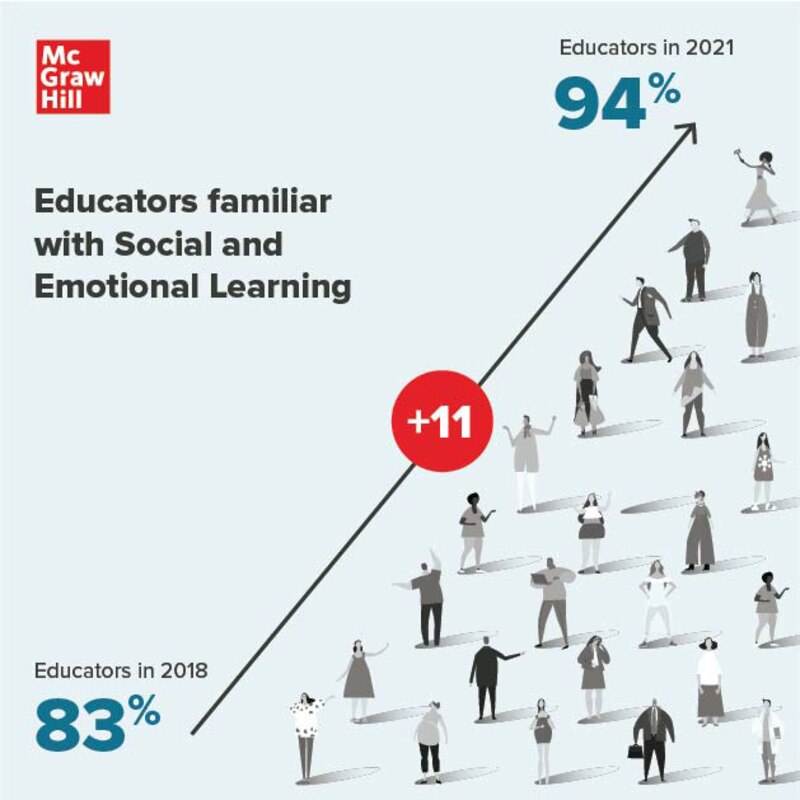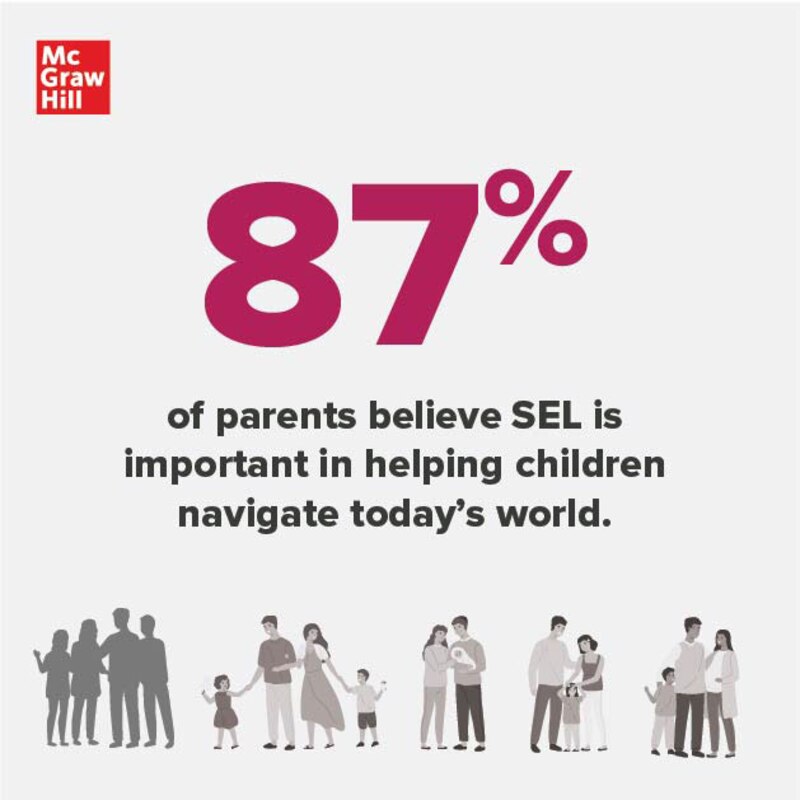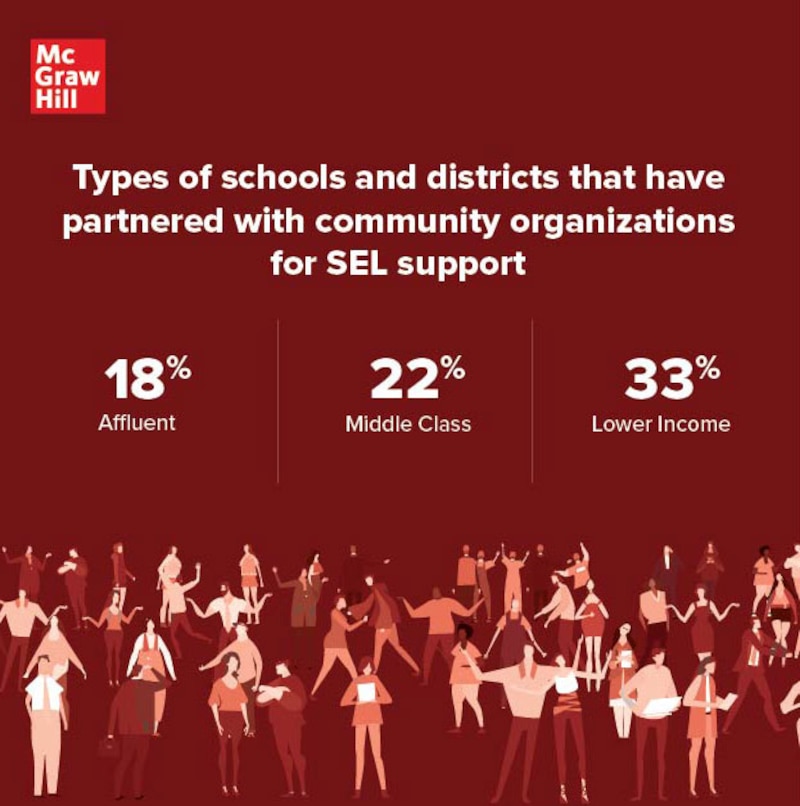Written by Sean Ryan, President, McGraw Hill School Group
This unique school year carries a weight that feels rather overwhelming. To support students in a post- (or, rather, ongoing) pandemic era, we must address social and emotional issues while also closing the academic gaps exacerbated by learning loss.
At first glance, these objectives might appear independent of one another — or even at odds. It’s a real concern that stressing rigor and remediation could feed a deficit mindset. Many parents and educators are rightfully concerned that efforts to accelerate unfinished learning could inadvertently and negatively impact student wellbeing.
However, what we know about the relationship between social, emotional, and academic learning would instead indicate that these objectives are in fact inextricably linked, and best addressed with an integrated, holistic approach that places student voices at the center of learning.

The social and emotional impact of the pandemic is complex and intertwined with academic impacts.
To get a clear picture of this year’s unique social and emotional challenges, we conducted a survey of educators, administrators, and parents on the importance of social and emotional learning (SEL for short) and the effects of COVID on student wellbeing. Here’s what we learned:
- Fifty-three percent of educators said COVID and/or the shift to remote learning has caused their students emotional distress and created attendance problems.
- Administrators and educators report that meaningful numbers of students have “given up” on school and show signs of depression, loneliness, and anxiety. They note that student confidence has plummeted, and many have disengaged from learning.
- Educators believe that SEL will help provide short-term benefits such as reduced behavioral problems (96%), improved grades (91%), and less emotional distress (95%).
Unpacking these results (which you can review in full here), underscores the connection between SEL and academic learning: A student’s ability to rebound from learning loss is dependent on their confidence with content, engagement with instruction, and overall well-being.
How do we empower learners socially, emotionally, and academically without defaulting to an approach that neglects the interdependencies of each element?
While there are many ways to approach the cross-sections of SEL and academic achievement, an initial focus on the student is recommended by the research. Listening to students and empowering them to own their learning can be a powerful driver of attending to the considerable social, emotional, and academic needs this year.

Prioritize student agency
The educators interviewed in our survey reported concerns that many of their students had “given up” on school during remote learning. Promoting student agency is critical to ensuring that students get excited about learning this year. Learning science research indicates that giving students opportunities for autonomy in learning can boost motivation. They are best positioned as active stakeholders with a role to play in how they learn and interact with lessons, rather than as passive recipients of information.
Promote a growth mindset
Just as we can’t let unfinished learning continue to hold back student achievement, we also can’t let students feel like the learning losses they experienced due to the pandemic are insurmountable.
When our partners at the Character Lab talk about a “growth mindset,” they encourage students to think of the brain as a muscle that can be trained and strengthened. Angela Duckworth, founder and CEO of the Character Lab, writes that when we tell students that growth mindsets are, in fact, backed by learning science — that neurons continue to grow as students grow and learn — they are more likely to adopt a growth mindset rather than a fixed mindset.
While working to promote agency and growth mindset as a means of combating learning loss at scale, consider technology that fosters these skills in tandem with academic remediation and acceleration. The right technology can give learners opportunities to reflect on their growth and exercise agency while working toward mastery in those critical areas impacted by learning loss.

Listen to students
I opened this article with the idea that students know what they need socially, emotionally, and academically. However, that doesn’t mean that all students can verbalize exactly the instructional supports they need, what material they’ve missed, or the depth of the impact the pandemic has had on their lives.
However, they can, when prompted, communicate how they feel. They can describe what excites them about learning, what causes them to have anxiety in the classroom, and what’s going on at home that makes it harder to stay engaged during class. They have so much to share about what they need to be successful — a commitment to asking and listening is essential.
Surveys, touchpoints, and conversations can uncover student needs and obstacles, sometimes in a group setting and sometimes in a less intimidating one-on-one setting. It’s vital to commit to also “listening” to what students don’t say, to “hear and understand” what they show. Rich, comprehensive student data sets can help ensure that students are interacting with the right material at the right time which increases their engagement and sense of accomplishment.
Finally, consider how technology in the classroom and at home can drive personalization and enhance a teacher’s understanding of the student’s learning journey. Technology that makes performance data available to the students themselves empowers students to reflect on and discuss their learning. Tools that rapidly deliver insights on student experiences to teachers are particularly valuable — every learning output from an individual student has the potential to better inform future learning in this virtuous feedback loop!
Empower students by listening, asking, and adapting
The challenge of addressing a variety of student needs in the context of environmental stressors is not new — nor is the importance of addressing these challenges from a holistic lens of the student experience under-appreciated.
Today, we already have the capability to apply technology thoughtfully to deliver highly personalized learning pathways, collect precise data about student learning, and even capture the social, emotional, environmental, and cultural nuances of the student experience. Technology is not simply a cold information processor; rather it can enable a stronger connection between a highly empathetic educator and students with predictably personal needs.
We don’t control the external circumstances within which we ask students to commit to their own personal learning. But by the very act of asking, listening, and adapting approaches for each specific individual, the promise of technology will be to deliver a much more effective and rewarding and uniquely human learning experience.
About the Author
Sean Ryan is president of McGraw Hill’s School group, which is responsible for providing PreK—12 educators and learners with programs, tools, and services supported by differentiated pedagogical instruction and purposeful technology. He was named to his position in April 2020 after serving as CEO of Wall Family Enterprise and before that as SVP and General Manager of Fuel Education, where he was responsible for strategy, marketing, sales, implementation, support and product development for the business.
Prior to these roles, Ryan was SVP of Sales, Service & Platform at McGraw Hill, leading the School group’s sales, implementation and training organization. His long career in education includes high profile roles at Campus Management, Scantron Corporation, and The Princeton Review of Japan. Sean is also a former military intelligence officer, having served in a variety of capacities in the United States. and abroad and rising to the rank of captain.
Sean graduated with a Master of Science degree in Management from the Stanford Graduate School of Business, a Master of Arts in International Relations from the University of Arizona, and a bachelor’s degree in Soviet Studies from the United States Air Force Academy.
Chalkbeat’s editorial staff had no role in writing or preparing this paid content. Learn about our sponsored content policy.


